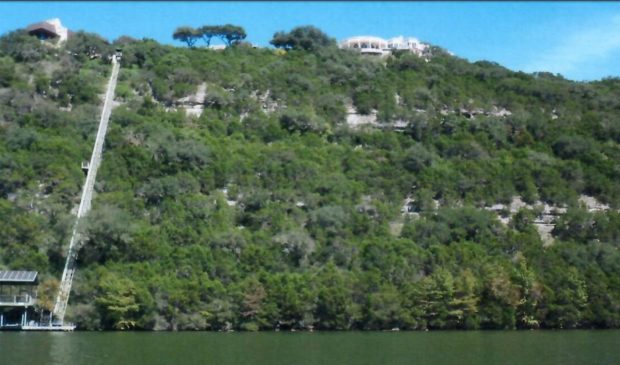Environmental Commission votes against tram, arguing for safety
Friday, August 3, 2018 by
Jessi Devenyns Everyone knows the saying, “If everyone jumped off a cliff, would you do it too?” Well, spoiler alert, the answer should be no.
Although that was not exactly the question that the Environmental Commission asked at its Aug. 1 meeting, it did contemplate the virtue of granting a variance to allow the property owners at 3335 Far View Drive, on the north side of Lake Austin, to construct a tram down the cliff face and over critical environmental features to reach their yet-to-be-constructed dock.
After a lengthy discussion, the commission agreed with city staff and recommended that the variance should not be approved. Commissioner Hank Smith voted against the motion and Commissioner Andrew Creel abstained.
“My review of the topography would say there’s not a safe route,” said Scott Hiers, the hydrogeologist who presented the case. Commissioners too were wary of allowing the construction of a tram through not one, not two, but three bands of rimrock, which code says cannot be constructed on within a 150-foot buffer.
“The reason that the critical environmental features were set aside is because they’re not solid. … That’s why we ask that people not build on them,” explained Commissioner Pam Thompson.
However, Rick Rasberry, an agent representing the owners of this property, noted that there are at least 14 similarly situated properties that have been approved for the exact same variance. He claimed the reasons that the city presented to deny theirs were unfounded.
“The city’s so-called report – I can’t see a fact in there, frankly,” he said.
Creel also expressed his hesitation with the city’s reasoning. “I think I could contest a number of findings of fact … not that I could contest the direction,” he said.
One of the major reasons that the city did not recommend this variance for approval was due to erosion concerns that the installation of a tram would cause. To install a tram, the construction company would need to clear a pathway directly down into the lake. According to Hiers, doing so would create a direct path for sediment to flow down the cliff and into the lake and affect the water quality.
Rasberry said he would “beg for (the commission’s) reasonableness” in this case. “It is the most environmentally protective and safe method in this particular case. Period,” he said. According to him, proper erosion controls, including mulch logs, would be installed to mitigate any potential disturbances that the construction would cause.
Photos presented from other tram projects showed that erosion controls are not always effective.
Safety wasn’t the only concern on the table though. “I don’t think trams belong because they interfere with the sight we want to see when we’re on the lakes,” explained Commissioner Mary Ann Neely. According to her, part of the role of the Environmental Commission is to preserve the beauty of Austin’s environment.
Commissioner Katie Coyne agreed, saying that on this particular project, “I think the design could be better.”
A better design, according to Smith, would be to jointly use the trams on either side of the property. Next door to the project in question, another tram is just beginning construction. Although Rasberry acknowledged that that solution was “certainly thinking outside of the box,” he said that the applicants would rather have their own tram so that they could have “reasonable usage” of their property.
Despite his case on behalf of the applicant, the commission recommended a denial of the variance. In closing, Creel noted that “there is so much that needs to happen in discussion with trams … it seems really inconsistent.” According to him, as the policy stands, “This is way too unclear for us to be making decisions on it.”
Photo courtesy of the city of Austin.
The Austin Monitor’s work is made possible by donations from the community. Though our reporting covers donors from time to time, we are careful to keep business and editorial efforts separate while maintaining transparency. A complete list of donors is available here, and our code of ethics is explained here.
You're a community leader
And we’re honored you look to us for serious, in-depth news. You know a strong community needs local and dedicated watchdog reporting. We’re here for you and that won’t change. Now will you take the powerful next step and support our nonprofit news organization?






